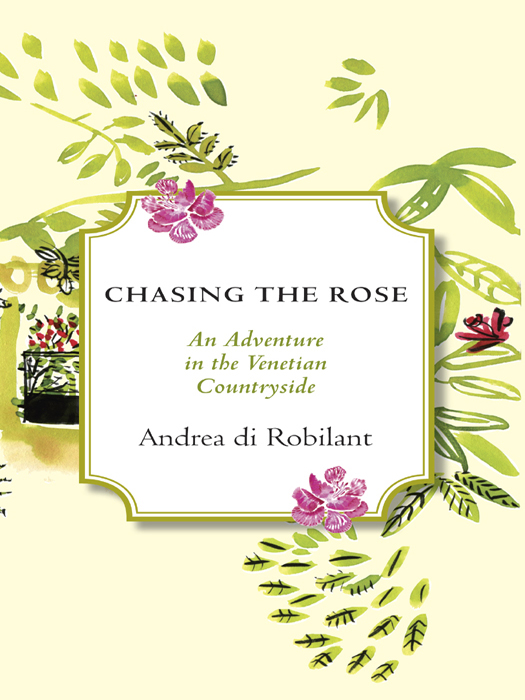
Copyright 2014 by Andrea di Robilant
All rights reserved under International and Pan-American Copyright Conventions. Published in the United States by Alfred A. Knopf,
a division of Random House LLC, New York, and in Canada
by Random House of Canada Limited, Toronto,
Penguin Random House companies.
www.randomhouse.com
Knopf, Borzoi Books, and the colophon are registered trademarks of Random House LLC.
Library of Congress Cataloging-in-Publication Data
Di Robilant, Andrea, [date]
Chasing the rose : an adventure in the Venetian countryside / by Andrea di Robilant; illustrations by Nina Fuga.
pagescm ISBN 978-0-307-96292-8 (hardcover)ISBN 978-0-307-96293-5 (eBook) 1.Old RosesItalyVenice Region. 2.RosesIdentification. 3.Di Robilant, Andrea, [date]. 4. Di Robilant, Andrea [date]Homes and hauntsItalyVenice Region. 5.GardensItalyVenice Region. 6.Memmo Mocenigo, Lucia, 17701854Homes and hauntsItalyVenice Region. 7.Josephine, Empress, consort of Napoleon I, Emperor of the French, 17631814. I.Title. sb411.65.o55d5 2014 635.933734dc23 2013023994
Jacket art by Nina Fuga
Jacket design by Iris Weinstein
v3.1_r1
ALSO BY ANDREA DI ROBILANT
Irresistible North
Lucia: A Venetian Life in the Age of Napoleon
A Venetian Affair
For my mother, Elizabeth Stokes
CONTENTS
I t was early summer and the new corn was growing as far as the eye could see on the flat Venetian mainland. Here and there the distant tip of a bell tower peeping over the stalks signaled the presence of a village lying low in that leafy green sea. Driving north from Venice, I kept losing my bearings on the narrow back roads, until a small, rusty sign came into view: ALVISOPOLIKM .
My familys association with this small town had ended nearly a century earlier. Yet the name still had a hold on my imagination, eliciting a strange nostalgia for a world I had never known but with which I felt intensely familiar.
Alvisopoli was the brainchild of my great-great-great-great-grandfather Alvise Mocenigo. At the end of the eighteenth century he reclaimed a vast tract of marshland that belonged to the family and, guided by a pioneering spirit that was truly at odds with the decadent mentality of the old Venetian ruling class, built a model farming and manufacturing community, with proper housing for the workers and their families, health care, and an educational system that included a state-of-the-art technical school. The community grew to become a proper little town, which he named after himself: the City of Alvise.
After the fall of the Venetian Republic, in 1797, Alvisopoli continued to thrive despite financial difficulties and the ravages of successive wars. In fact, its greatest expansion took place during the time of Napoleon. But Alvise died prematurely, in 1815, shortly after the collapse of the empire. It fell on his widow, Lucia, and afterward their son, Alvisetto, and his heirs, to carry on his visionary project. As it happened, the utopian ideal and its lan faded during the nineteenth century. Alvisopoli became a farming estate like many others, the only difference being that it was much larger than the other big properties in the region.
My grandfather Andrea di Robilant inherited the property from two childless Mocenigo aunts after World War I. He sold it in the 1930s to pay his debts, and the estate was broken up. The new owners continued to farm the land, but they abandoned the village, including the main villa and the surrounding buildings. For a long time Alvisopoli was little more than a small ghost town, lost in the Venetian countryside. But in the mid-1980s a state agency stepped in to convert the old buildings into a low-income housing project. Some twenty years later, I was driving through that part of the country and decided it was time to make a belated pilgrimage to the old family estate I had heard so much about as a child.
I emerged from the cornfields directly onto the main square of the town and parked the car in front of the old Bar Mocenigo. The layout of the town was intactno new buildings had been added since the early nineteenth centurybut the impression of stepping back in time vanished as soon as I reached the main villa, where the new tenants had moved in. Satellite dishes were secured to the windowsills. Clothes were hanging out to dry. In the back of the main house, the garden had been divided into weedy vegetable plots. There was a melancholy shabbiness about the place that reminded me of Eastern Europe during the Cold War.
I was about to turn away and head to Bar Mocenigo to lift my spirits with a shot of grappa when a short, portly man I took to be the caretaker emerged from the villa amid a loud jangling of keys. I am Benito Dalla Via, he announced. Can I be of any help? His face lit up when I told him my family had lived on the estate for many generations. Come with me, he said. He took out the batch of keys and led me to the little church that Alvise Mocenigo had commissioned in the early nineteenth century. Here are the tombs of your ancestors, Benito said as he pointed to the marble slabs under which lay the remains of Alvise and several of his descendants.
It turned out Benito was not the official caretaker, but rather a self-appointed one. The housing board had assigned to him and his wife, Giuditta, a small apartment on the ground floor of the villa. Giuditta pruned and watered the plants in the condominium courtyard. Benito, a retired hotel porter with time on his hands, had taken up embroidery. The walls in the sitting room where I was invited for coffee were covered with framed renderings of flowerpots, biblical scenes, and Venetian vistas.
After coffee, Benito rose to his feet and commanded me to follow him. I am taking you to the park, he said, and led me past the vegetable plots behind the villa to a peeling old gate. He pulled out another set of keys, and we entered a very thick wood with tall trees, brambles, rotting lumber, and stagnant waters. There were occasional signs of a grander past: a gnarled boxwood hedge, a broken bench, and here and there the traces of an old pathway. But the park had long reverted to wilderness.
As we made our way into the scrub, I realized Benito was looking for something specific he wanted to show me. Soon he came to a halt in a clearing and pointed in the direction of a bush about three feet high that was covered with the loveliest pink roses. As the surroundings came into focus, I spotted similar rose shrubs growing in the vicinity, as if a secret garden had sprung up in those woods over the years.
I walked over to the closest plant and took a rose in my hand. It was silvery pink, very light at the center and darker on the outside. The diameter was about three inches. The petals were loose, and fell to the ground as I observed the flower. The scent was very strong and reminded me of peaches and raspberries. Although I did not know much about roses, everything about this onethe delicate color, the sweet fragrance, the way it carried itselfsuggested this was an old rose of some importance that had been growing wild in these woods for a very long time. Its presence was mysterious yet assertive.













